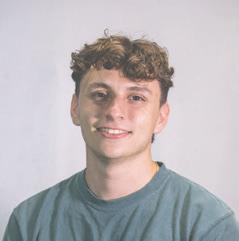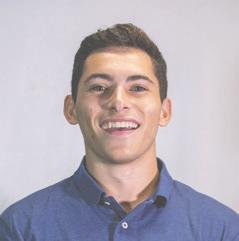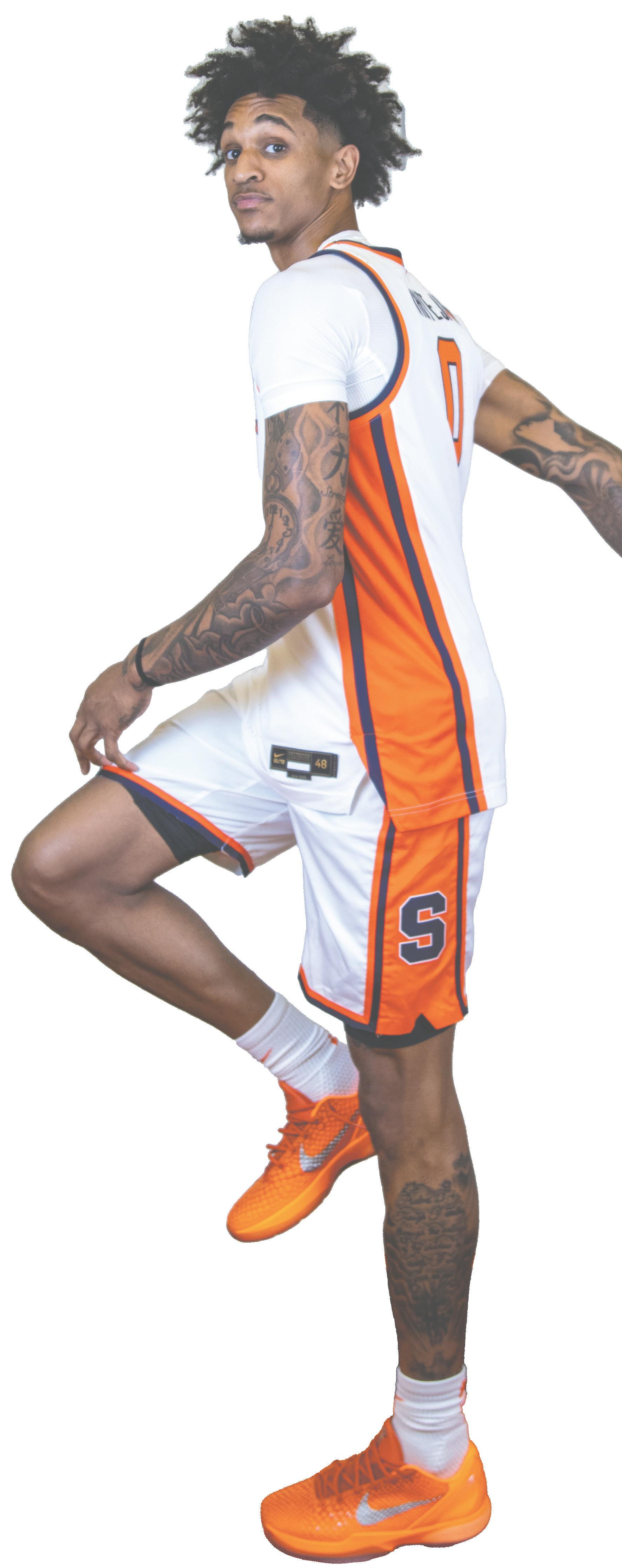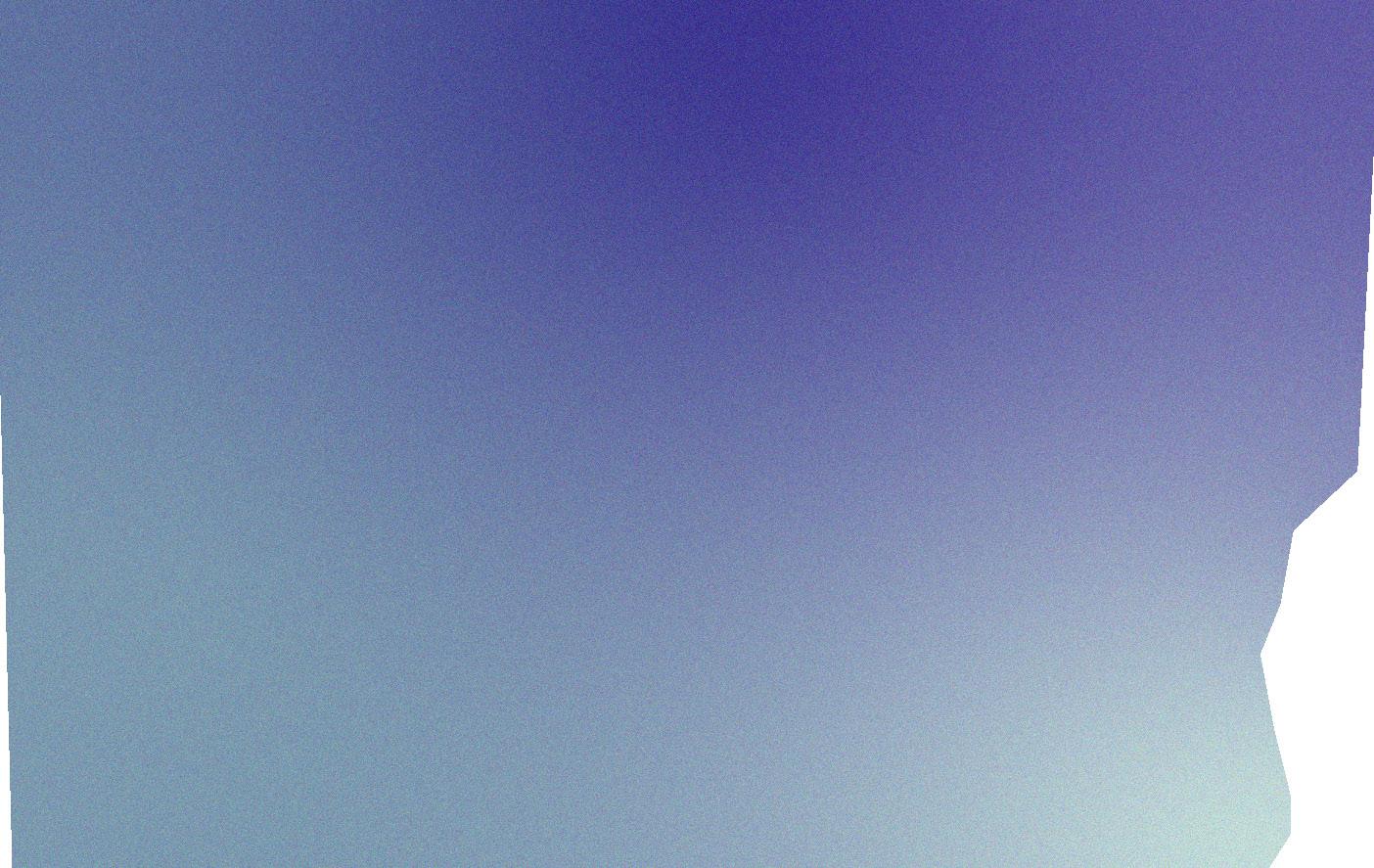PAGE 4

3
The last two years learning from Dyaisha Fair and Georgia Woolley prepared Sophie Burrows to be Syracuse’s leader.





Culture@dailyorange.com
Sports@dailyorange.com
Digital@dailyorange.com
Design@dailyorange.com
Photo@dailyorange.com
The Daily Orange is an independent, nonprofit newspaper published in Syracuse, New York. The editorial content of the paper — which started in 1903 and went independent in 1971 — is entirely run by Syracuse University students.
The D.O., a 501(c)(3) nonprofit, is editorially and financially independentfromSU,andthepaperreceivesnofundingfromthe university. Instead, The D.O. relies on advertising revenue and donations to sustain operations.
This fall, the paper will be published Thursday when SU classes are in session. The D.O.’s online coverage is 24/7, including while SU is on break.
To show your support to The D.O.’s independent journalism, please visit dailyorange.com/donate. Donations are tax deductible.


DEAR READERS,
Syracuse basketball is just days away. Last season, both the men’s and women’s squads missed the NCAA Tournament. Now, each side has reloaded its roster with top-tier freshmen and transfers.
On the men’s side, SU reeled in top-35 prospects Sadiq White and Kiyan Anthony, the son of NBA Hall of Famer Carmelo Anthony, and six transfers to pair with returners J.J. Starling and Donnie Freeman.
For the women’s team, head coach Felisha Legette-Jack saw most of her top scoring options depart but retained second-leading scorer Sophie Burrows. Of many newcomers, Texas transfer Laila Phelia and four-star freshman Camdyn Nelson can produce alongside her.
The Daily Orange’s 2025 Basketball Guide has all you need to know before the season begins.
Thanks for reading,

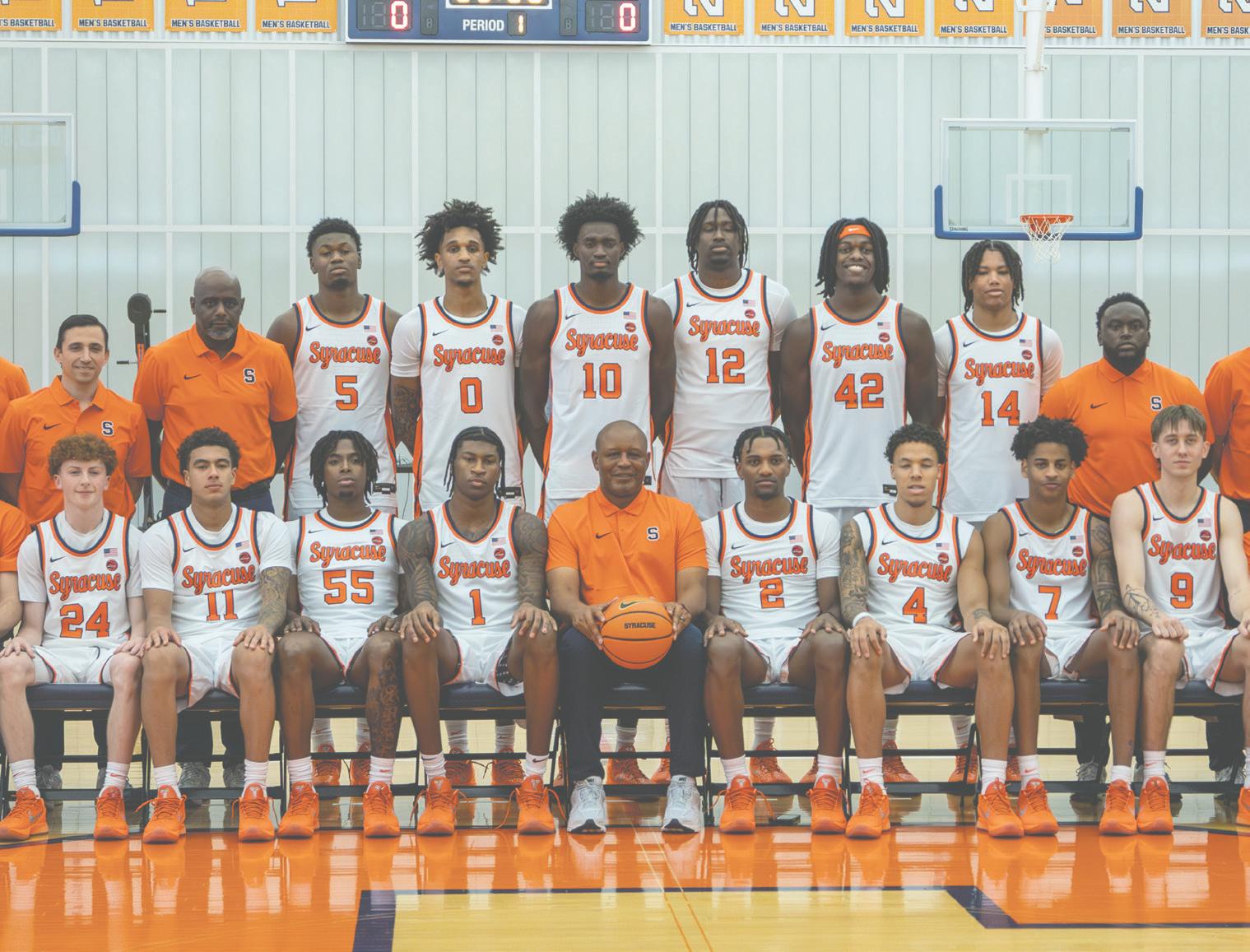
NOAH NUSSBAUM SPORTS EDITOR
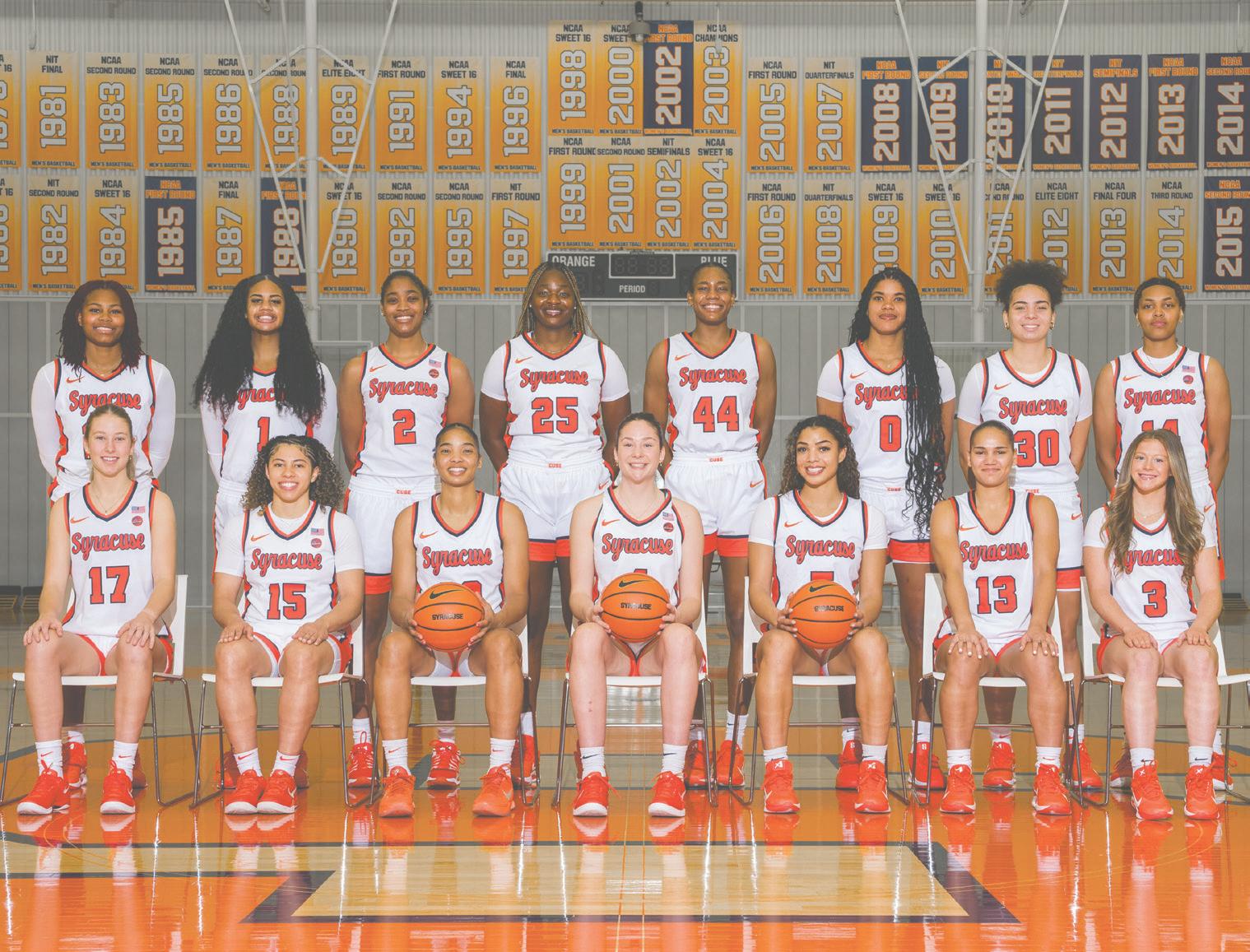


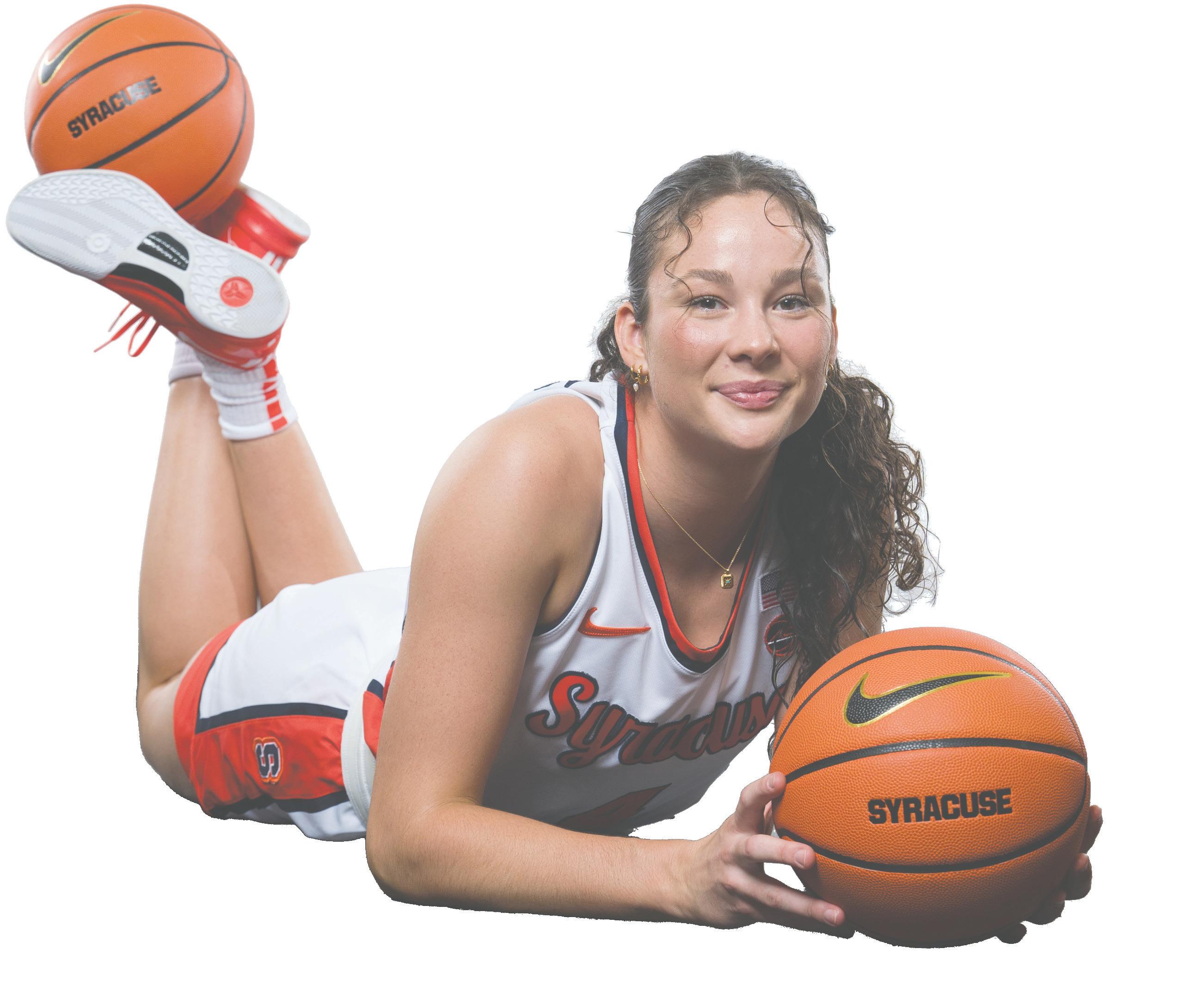
Everyone called her Buzz, and Sophie Burrows wasn’t sure why. She’d just returned for her second season with the Diamond Valley Eagles, a team in Australia’s NBL1, arriving late after playing with the Melbourne Boomers of the Women’s National Basketball League.

Most of the faces around her were familiar, but her head coach, Dee Butler, wasn’t one of them. Butler had just taken over the Eagles — and she hadn’t come alone. Among the new arrivals was a player named Sophie Byrnes.
Although Burrows had already played for Diamond Valley, the older Byrnes’ seniority took priority. So while Byrnes remained Sophie, Burrows became Buzz.
“First of all, I didn’t even have a say in this decision,” Burrows recalled thinking. “Second of all, why does she get to keep her name?”
Burrows reluctantly got used to Buzz. Now, she’s evolved far beyond the nickname after starting her collegiate career at Syracuse. In her first two years at SU, Burrows learned from former guards Dyaisha Fair and Georgia Woolley. With Woolley — the Orange’s No. 1 option in 2024 — graduated, Burrows is positioned to become the Orange’s next cornerstone this season.
“Sophie is really doing a tremendous job of being that player that was here last year and owning her right to be on the court with anybody,” SU head coach Felisha Legette-Jack said at Media Day on Oct. 17.
Reaching this point took a leap of faith. Three years earlier, Burrows had agonized over whether to chase a professional career with the Boomers or take a chance thousands of miles away.
When weighing her options, she considered the journeys of fellow Australians Alanna Smith, who went from Stanford to the Minnesota Lynx, and Ezi Magbegor, who moved straight to the Seattle Storm. But Burrows couldn’t decide on her own. She needed something to tip the scales.
Then the phone rang. When Burrows answered, a familiar voice came through — one she’d heard just a month earlier when she visited Syracuse. It was Legette-Jack calling to congratulate Burrows on her choice to play pro.
Burrows was confused, having not yet made a decision. She admitted she was leaning toward staying in Australia, but speaking with LegetteJack made her reconsider. Within minutes, Burrows told Legette-Jack she’d join the Orange.
“I could always go back to playing pro in Australia, but I couldn’t just come back to playing college basketball,” Burrows said. “I wasn’t willing to give up that opportunity.”
Burrows, who has diabetes, could be at a slight disadvantage, but no one close to her saw it that way. Burrows’ father, Mark Burrows, said her diabetes diagnosis helped her mature. Diamond Valley team manager Barb Evans said Burrows always managed it herself.
She’d been set back throughout her life. She was the youngest of three sisters. She had a Dec. 31 birthday, which meant being at the tail end of every age group. Her floor presence was so timid some compared it to a mouse. But Burrows was never fazed.
Sophie Burrows spent 2 years behind Syracuse’s stars. It's her turn now.
B y Jordan Kimball

through that and really understand where I was coming from.”
39.1%
Burrows accounted for 39.1% of SU’s total 3-pointers in the 2024 season
Once she left Australia, she’d already built an extensive resume. She was a member of Australia’s 2022 U18 FIBA Women's Asian Championship team in Bengaluru, India. Her final stop before Syracuse was the 2023 FIBA U19 Women's Basketball World Cup in Madrid, Spain.
“It just made me realize that’s really what I wanted to do,” Burrows said. “I wanted to (eventually) go pro and keep playing basketball.”
Burrows’ travels forced her to miss SU’s first six weeks of practice before the 2023-24 season. When she arrived in Syracuse, all but one of her teammates had left for a two-week break: Woolley. A reserved newcomer, Burrows relied on Woolley for direction, from exploring campus to getting a feel for Syracuse. Woolley, who’d navigated the transition from Australia two years earlier at Buffalo under Legette-Jack, became Burrows’ guide to her new life.
When basketball resumed, Burrows continued to follow the lead of Woolley. Shifting from Australia’s slower tempo, Woolley helped Burrows realize it wasn’t a physical adjustment — she needed to think faster.
“It’s a big move. It’s a lot of change,” Burrows said. “It was really nice to have someone help me
When Syracuse’s season began, Burrows also looked to Fair. Fair — who scored the third-most points in NCAA women’s basketball history — was a once-in-a-lifetime guard, Burrows said. She asked for the ball, and for the right reasons.
But it left Burrows in another precarious position. She’d averaged double-digit points across almost 30 minutes per game in her final season with Diamond Valley. With the Orange in 2023-24, she uncharacteristically honed her focus on offensive rebounding and rim-to-rim defense, defining an underwhelming freshman year where she averaged 4.6 points per game.
“She went to college, and she didn’t play like Sophie,” Mark said of Burrows’ first year with SU.
“A lot of it was just in my head, a lack of confidence, a lot of overthinking, that kind of stuff,” Burrows added.
That same year in the NCAA Tournament, though, Burrows showed a glimpse of herself. She played just nine minutes in SU’s first-round win over Arizona, but when starting guard Alaina Rice suffered a head injury, Burrows was thrust into the starting lineup against UConn. She responded with a season-high 18 points in 39 minutes during the Orange’s 72-64 loss.
“It’s the big games where she actually plays better,” Mark said. “She likes the pressure. She likes being on the big stage.”
With Fair departing, Syracuse was building around Woolley, and Burrows expected her role to expand. Over the offseason, she returned to Australia to practice with Diamond Valley, also spending hours putting up shots on the basketball hoop outside her home, Mark said.
When she came back to Syracuse, she’d transformed into a reliable scorer, while further developing her off-ball skills to complement Woolley. It didn’t take long for her presence to be felt.
In four of her first six games, Burrows scored double-digit points. But the Orange were
Syracuse later fell to 8-13 before a February tilt against Virginia Tech.
It was just another game, Burrows’ 52nd to be exact. But it’s when the tide turned on her Syracuse career.
About three minutes in, Burrows made her first bucket. Another followed 33 seconds later. Then another. By halftime, Burrows was sitting at 17 points.
When Legette-Jack looked into Burrows’ eyes during a timeout, Burrows responded by asking what the next play was. LegetteJack was sure Burrows would drop a “30piece.” The fire she’d lacked as a freshman had returned.
When the buzzer sounded, Burrows had a career-high 28 points on eight 3s, a statement that signaled what was to come.
“(Sophie’s) gonna be the future of this team,” Legette-Jack said postgame. “She’s so locked in, she’s so special.”
SU’s win over the Hokies may have sparked Burrows’ surge, but the rest of the team couldn’t keep up. The Orange stumbled to a 3-4 finish, culminating in a second-half collapse against Boston College in the ACC Tournament First Round, where they blew a 19-point lead.
Burrows grew accustomed to stepping into new roles. Now, she’s embracing her biggest one yet — this time as SU’s leader.
She started by focusing on what went wrong in the Orange’s historically bad year. She said it stemmed from the energy and buyin from others.
Her plans were briefly derailed over the offseason, though. She was sidelined for five months after undergoing shoulder surgery to repair a torn labrum from her freshman year. She said it needed to happen to be fully ready for the 2025-26 campaign.
SU strength coach Matt Wietlispach, SU trainer Karen McKinney and Burrows’ physical therapist Lachlan Fooks spoke via Skype, emphasizing external rotations and Google Sheet workouts Wietlispach had constructed. It required patience she’d never experienced before, Burrows said. She just itched to play again.
Once she returned to Syracuse, she was only about 70% recovered, gradually easing from stationary bike workouts to running on turf and grass. Now, she’s close to full health — back on the court and moving like herself.
“She can pretty much do anything,” Wietlispach said. “She’s gonna be deadly.”
When Burrows visits Butler and Evans in Australia, Buzz sometimes resurfaces. It’s a name she’s learned to love, one that marks her growth, even if she initially shed it.
At Syracuse, though, she doesn’t need a nickname. Her slow start told part of the story, as did her NCAA Tournament breakout and her blazing performance versus VT. She’s hoping the upcoming season will only add to that.
Now, everyone knows who she is. She’s finally just Sophie. jordankimball28@gmail.com

background based on how he carries himself. But as the son of basketball royalty, it’s impossible not to know who Kiyan is.
“It’s definitely overwhelming,” Kiyan said. “I’m not even gonna lie and sit here like it’s a bed of roses. It’s definitely a lot of pressure.”
By choosing to play for Syracuse, Kiyan is taking the spotlight head-on, playing for the program that kick-started his father Carmelo’s Hall of Fame career. Before practicing, he sees Carmelo’s name imprinted on SU’s facility. In the JMA Wireless Dome, Carmelo’s retired No. 15 will reign down from the rafters.
Still, Kiyan says he’s not chasing Carmelo’s legacy. He’s focusing on adding to it while building his own name.
Even through the Orange’s recent “down years,” Carmelo said he and Kiyan — a shooting guard and 247Sports’ No. 32 recruit in the 2025 class — stayed locked into the program. Now, in a pivotal season for SU as it looks to snap its longest March Madness drought in over five decades, Kiyan is tasked with helping restore the “Orange Standard” — encapsulated when Carmelo led Syracuse to its lone national championship in 2003.
“You talk about legacy, and you talk about family dynamics, you talk about passing things on down to your family, to your kids. And this is something that we passing, and we passing the baton to him,” Carmelo told The Daily Orange. “And now whatever he do with it, he do with it, and that’s on him.”
Standing center stage with Kiyan, Carmelo fought — and failed — to hold back tears. On the evening of Nov. 16, 2024, Carmelo addressed the crowd at Kiyan’s commitment party.
Throughout his life, Kiyan said he viewed Carmelo as a soldier. But this moment? Carmelo showed a side that his son explained he’s only seen a few times.
The raw emotion meant a lot to Kiyan. It showed him how much his Syracuse commitment meant to Carmelo.
Deep down, Carmelo yearned for this.
During Kiyan’s recruitment, which was down to SU and Southern California, he thought, What are you waiting for? Once Kiyan chose the Orange, he breathed a sigh of relief. You had me nervous for a second.
Throughout his son’s life, he never interfered with coaches or trainers. As Kiyan was sought after by top colleges, Carmelo said he never pushed his son toward Syracuse and that he wanted him to be recruited just like every other prospect.
Kiyan added that his father let him take his time with the decision, never pressuring him.
“I think he understood and understands what this really means, as far as putting an ‘S’ on your chest,” Carmelo said.
But the magnitude of Kiyan playing for Syracuse is far different than Carmelo’s. Before Carmelo — the No. 2 recruit in his class — practiced with the Orange, they didn’t know much about him. Former SU teammate Hakim Warrick admitted he initially had doubts because he thought Carmelo

Cameron and Cayden Boozer can relate, Kiyan knows he’s different from most.
He says he always tries to “act as normal as possible,” not show any entitlement, be humble and learn every day. But sometimes, Kiyan just wants to be the mellow, Clash Royale-obsessed 18-year-old.
Kiyan’s cousin, Mekai Vazquez — also an SU freshman — described his cousin as a homebody who loves watching TV, movies, playing video games and online streaming. It’s Kiyan’s first time living away from home, but he says having Vazquez and three of his childhood best friends — who play basketball at nearby colleges — living five minutes away has kept him level-headed.
Kiyan’s mother, La La, said having his cousin and friends nearby helps her son feel at home and provides the support he needs. She emphasized how important it is for Kiyan to have the right circle around him — something she understands well as a famous actress, producer and businesswoman.
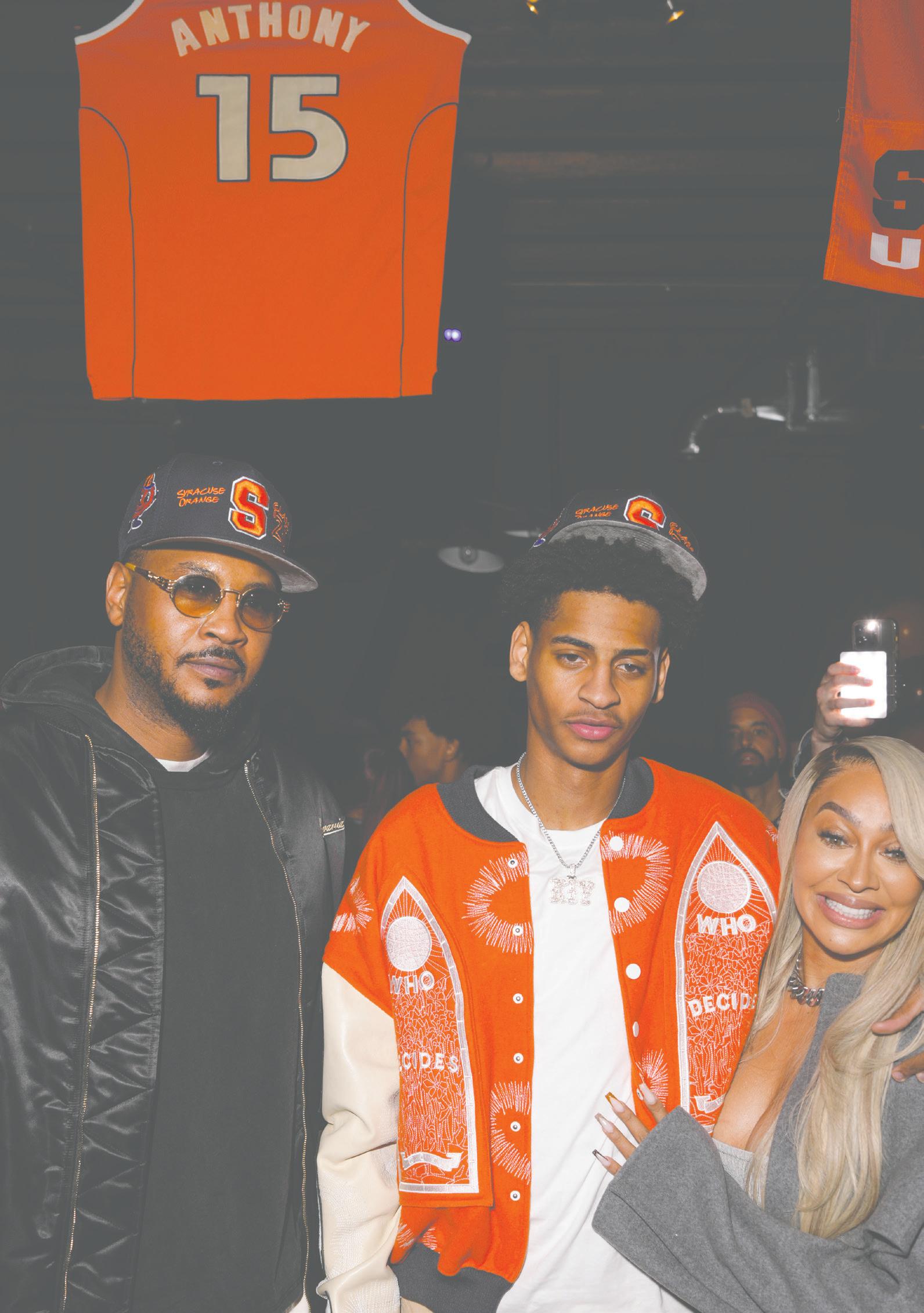
At the time, Long Island Lutheran — where Kiyan transferred midway through his sophomore year after attending Christ the King in the Bronx — was amid its first season in what’s now the Nike EYBL Scholastic Conference. The league allows the nation’s best high schools to compete against each other.
Kiyan didn’t have many college offers when he transferred. He explained that transferring to LuHi was his best chance to gain exposure. But since his mid-season transfer made him ineligible, that opportunity would have to wait until his junior year.
For when that moment arrived, Carmelo’s earlymorning workouts were invaluable. Each morning, they picked a spot on the court and honed in on Kiyan’s ability to score — a second nature to Carme lo, who scored the 10th-most points in NBA history.
Then it was time for school, LuHi’s practice after classes and another workout at night. Rinse and repeat.
“My dad, he just kept me level-headed, and I just kept doing it,” Kiyan said. “I didn’t know when it would pay off, but it eventually did.”
Kiyan didn’t have to do the work. He knows he doesn’t have to be playing basketball. He knows he doesn’t need to make it out of the mud — like how Carmelo rose from rags to riches out of Myrtle Avenue in Baltimore.
Formulating his own story and path helped drive Kiyan, Vazquez said. When Kiyan was in middle school, Vazquez remembers social media accounts posting clips of Kiyan, highlighting that he was Carmelo’s son.
Meanwhile, Harrington — a strength and performance coach in the New York City area — added that Kiyan “worked his freaking ass off” to get where he is now.
Pairing self-scheduled strength training with a growth spurt, Kiyan now stands 6-foot-5 and weighs 185 pounds.
When Kiyan isn’t hanging out with his circle, teammates or playing basketball, he’s usually alone in his apartment. La La explained that he likes to unwind by himself after a long day.
“It's an essential part of him keeping a clear head,” La La told The D.O.
Outside of his friendly confines, La La added that Kiyan is handling the transition to college well, and he’s excited for the season to start.
La La said she’ll frequently be in Syracuse once games begin. Meanwhile, Kiyan said Carmelo is managing his schedule around his new broadcasting gig with NBC, but he’ll be in attendance as much as possible.
Though she declined to give any names, La La noted there'll be “some really cool surprises” joining her in supporting the Orange throughout the year.
That’s the Kiyan effect.
Every morning, Kiyan’s 6 a.m. alarm was his father.
Before a nearly hour-and-a-half commute to school from Brooklyn to Nassau County, Kiyan worked out with Carmelo. He feels it’s one of the most important decisions he’s made in his basketball career.
Naysayers flooded the comments, saying he wasn’t as good as his dad — or good, period. At that point, Vazquez said, Kiyan’s desire to create a name for himself was born.
“He's never really been worried about being in his dad's shadow,” Vazquez said. “He's been sort of independent his whole life.”
But when Kiyan entered high school, standing about 6-foot and 150 pounds, he had a ways to go. Kiyan admitted that as a freshman, he wouldn’t have believed himself if he said he’d be a top player on a top-five team in the nation as a senior.

Brandon Gardner, who was named “Mr. Basketball” in New York as a senior at Christ the King in 2023, remembers Kiyan being “real small” but a “little dog.” On a loaded team, Kiyan’s role was limited as he was still developing.
Ten games into his sophomore season, Kiyan decided to transfer and focus on his development for the rest of the year. Beyond honing his game with Carmelo and renowned trainer Chris Brickley, Kiyan developed his body with Garson Grant and Brian Harrington, among others.
Grant, an independent trainer in New York City who also trains Carmelo, said Kiyan was the most focused high school athlete he’s ever worked with.


gible. Buck said he used Kiyan in a scout-team-like role, mirroring an opposing team’s best player. Additionally, his personality during games was infectious.
“He's jumping up and down, he's cheering guys on,” Buck said. “People like that, if they drain energy versus give energy, it can change the way your team performs.”
Once Kiyan returned to the court on the AAU circuit during the summer, Gardner, who now plays for Sacramento State, realized from afar that it “got real” for Kiyan when he was “frying” his competition. Even so, Kiyan was still developing.
While Buck said Kiyan played a crucial role as a junior, he mostly came off the bench since V.J.
Kiyan became a senior, his work began to show.
As LuHi finished the year ranked in the top five nationally — a feat it achieved all three seasons he was with the program — Kiyan scored a team-high 15.7 points per game alongside three other current Power Four players and two top-50 2026 recruits.
Kiyan was no longer just Carmelo’s son. He was Kiyan.
Carmelo looked at Gerry McNamara, delivered the punchline and laughed. When Kiyan visited Syracuse for the first time in his recruitment, McNamara — a former SU assistant who’s since become Siena’s head coach — pulled his former Syracuse teammate to the side.
Before having their numbers hang together in the JMA Wireless Dome’s rafters, they helped power the Orange’s 2003 title as freshmen. McNamara knew how much Syracuse meant to Carmelo — but he needed to gauge Kiyan’s true interest.
Privately, McNamara asked Carmelo if this was what Kiyan was looking for and if he wanted to go to SU.
“Yo, I’m here for a reason, bro!” McNamara recalls Carmelo quipping back before laughing.
The Orange became Kiyan’s first Power Four offer in November 2022, when he was a sophomore at Christ the King. While recruiting him, SU head coach Adrian Autry, who took over for Hall of Famer Jim Boeheim in 2023, said he was impressed with how Kiyan was “deadset” on forging his own way.
As he became one of the elite prospects in his class — evidenced by his MVP honors at the Jordan Brand Classic, an annual basketball event that showcases top high school players — Kiyan began racking up offers.
After narrowing his options to Syracuse and USC, Kiyan explained that the Trojans made a good run, and he didn’t make his decision until about a week before his commitment party. Kiyan said NIL wasn’t a factor, but the programs offered similar dollar amounts; he mentioned it was a conversation because he wants to “get paid too.”
“Aside from (Carmelo) coming here, I feel like this was the best option,” Kiyan said of choosing SU.
Entering his freshman year, Kiyan says he can contribute three-level scoring and that he has underrated playmaking ability. Autry added he expects the freshman to contribute right away due to his offensive talent.
Kiyan noted that he’s looking to spend one or two years at Syracuse before jumping to the NBA.
“Thankfully, he’s ready,” Autry said. “He just has to continue to get better, like most freshmen.”
While he’s a natural shooting guard, Kiyan says he’s played point guard in practice and that he’s also comfortable playing small forward. Per Buck, Kiyan boasts a Stephen Curry-esque ability to slither in and out of space with contorted finishes alongside his outside shooting prowess.


It’s a vastly different playstyle than his father, who at 6-foot-8 possessed elite skill, strength and quickness playing both forward positions. However, Buck noted Kiyan can pour in buckets like Carmelo.
When Carmelo arrived on campus in 2002, he instantly became the Orange’s best player. He then had a transcendent one-and-done campaign, becoming the first freshman in modern men’s college basketball history to lead a title-winning team in scoring with 22.2 points per game.
Those are expectations Kiyan, or any freshman in college basketball, shouldn’t have. Kiyan said whether he starts or comes off the bench — which seems likely with Naithan George and J.J. Starling as SU’s starting backcourt — he feels he’ll play a lot and wants to contribute any way he can.
“I think it's just great for him to be able to follow in his dad's footsteps, and hopefully he can turn things around like (Carmelo) did,” said Warrick, whose number is retired by SU.

I’m not even gonna lie and sit here like it’s a bed of roses. It’s definitely a lot of pressure.
Kiyan Anthony SYRACUSE FRESHMAN SHOOTING GUARD
Before Carmelo’s arrival, Syracuse had missed the NCAA Tournament for the fifth time across Boeheim’s first 26 years at the helm. Then Carmelo sparked its national championship run.
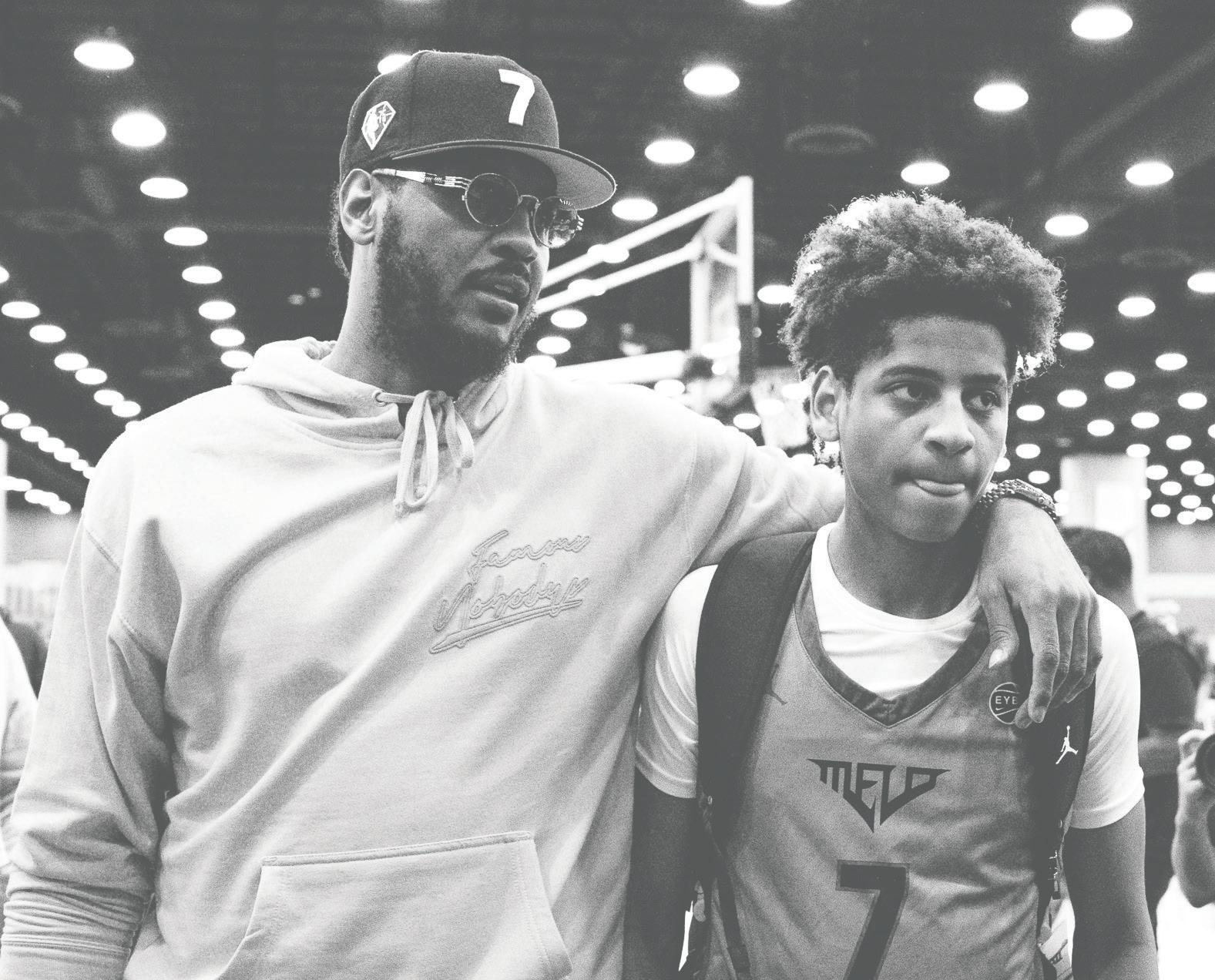
Today, between Autry’s first two campaigns and Boeheim’s last two, the Orange are in the midst of their longest NCAA Tournament spell since missing six straight from 1967-72. Autry mentioned Syracuse being one of the best programs in college basketball history when describing the “Orange Standard” during his media day press conference.
By leading SU to the 2003 title, Carmelo is synonymous with the “Orange Standard.” And all it takes is one look at Kiyan’s left bicep to understand what he’s chasing, where a tattoo replicates one of the most iconic photos in Syracuse sports history — with several differences.
Carmelo’s No. 15 becomes Kiyan’s No. 7. “Kiyan chooses Syracuse” replaces “Syracuse wins NCAA title.” CHAMPS turns to LEGACY.
In committing to SU, Kiyan is building off the legacy his father trailblazed over two decades ago. And by inking it on his body, he’s showing the world he’s ready to embrace it.
As cameras, reporters and fans surrounded the red carpet, Kiyan stood by Carmelo’s side. He donned a brown suit, sunglasses and a flashy chain with his nickname “KIY.” Every step of the way, he remained at his father’s hip.
Later in the night, when Carmelo took the stage to deliver his Hall of Fame speech, Kiyan sat stoically in the first row. After delivering what Kiyan felt was a touching speech, Carmelo embraced his son with a long hug before returning to his seat.
Following the ceremony, Kiyan said he and Carmelo cried in the car. It was a relief, because he’d never seen his father that nervous before anything.
With Carmelo officially a Hall of Famer, Kiyan emphasized nobody can speak down on his name. That door to Carmelo’s life had shut.
But as Kiyan prepares to begin his collegiate career, the doorknob on another is starting to turn. Following his SU exhibition debut, Kiyan said it was a “blessing” to finally play for Syracuse.
Once the door to his career opens as the Orange’s season officially starts, all eyes will be on Kiyan.
It’ll be impossible to hide in the dark.
An eye injury sidelined Laila Phelia at Texas. Syracuse is her 2nd chance.


LEventually, she regained enough sight to begin the season with the Longhorns. But after playing just eight games, she needed another surgery. While it wasn’t an easy decision, Phelia felt it was best to sit out the year to let her vision adjust.
She mainly focused on rebuilding her hand-eye coordination, so she learned to juggle. While the Longhorns turned in a 35-4 season, Phelia tried to stay involved whenever she could. That often meant tracking her teammates’ shots during practice, scouting opponents or attending her teammates’ individual workouts.
By the end of the Longhorns’ season, Phelia knew she wanted to use her final year of eligibility somewhere new to rediscover herself as a player.
When Phelia entered the portal, she only spoke with about five schools, including South Carolina and LSU. But Phelia said she needed a coach who understood her situation — she was looking for a place to rebound, not one that expected her to be the same as she was two seasons before.
“Other coaches, in their mind, I'm the same player that I was. But I personally feel like it's gonna be a little different,” Phelia said. “It's just needing that patience and that time to actually get back.”
SU head coach Felisha Legette-Jack, who coached Phelia with the U.S. national team in 2023, was a perfect match.
“We got blessed with someone like her because everybody in the country was wanting her,” Legette-Jack said. “I guess she remembered me a little bit from USA Basketball, and I definitely remembered her. It was a perfect storm.”
“I’m really thankful she’s a part of this team,” Legette-Jack added. “Now we just gotta get the success that she's accustomed to.”
Winning has followed Phelia everywhere she’s gone. At Mount Notre Dame High School (Ohio), Phelia won 72 consecutive games as a starter and three state championships. Mount Notre Dame head coach Scott Rogers called Phelia “probably the most athletically gifted player” they’ve had.
So, Phelia piled up Division I offers as a fourstar recruit and the No. 28 overall player in the 2021 class. She stayed close to her hometown of Cincinnati, Ohio, choosing Michigan.
Phelia was immediately thrown into the fire with the Wolverines, averaging nearly 23 minutes per game as a freshman. Michigan made the NCAA Tournament as a No. 3 seed, and Phelia started all four games of the Wolverines’ Elite Eight run. Michigan’s Sweet 16 matchup with South Dakota was Phelia’s fondest memory. The squads were deadlocked at 48 points with 30 seconds
aila Phelia should’ve been on the court. It was an early spring practice in Tampa, Florida. In a few days, her Texas Longhorns would take the court for a Final Four meeting with South Carolina.
Phelia transferred to Texas for moments like this. As a former First-Team All-Big Ten selection at Michigan, she expected to help the Longhorns make a national title push. She wanted to be tuning up her teammates with aggressive perimeter defense or firing up 3-point shots. Instead, she swapped the basketball for a clipboard. Phelia sat on the sideline, tracking her teammates’ makes and misses from afar. It was just one way she tried to stay involved after a season-ending eye injury.
“It was one of those things I had to be positive about,” Phelia said. “I just found happiness by cheering on the team, helping with whatever the team needs and just being that person that everyone can come to.”
After a stellar three-year stretch at Michigan, which included two 16-point per game seasons and an Elite Eight appearance, Phelia went to Austin to play a key role with a national championship contender. Instead, she spent most of the year sidelined with a detached retina — a genetic condition where a layer of tissue detaches from the back of the eye — as the No. 1 seed Longhorns advanced to the Final Four.
Phelia pursued a medical hardship waiver to reclaim her final year of eligibility. She used it to transfer to Syracuse,

where she hopes to help the Orange adopt her winning ways while reestablishing herself as one of college basketball’s premier two-way guards.
“While I was adjusting to my new vision and trying to get back to that player that I was, I felt like it would be best to go elsewhere and rebuild that confidence,” Phelia said. “I went into a program (at Texas) that had their players, had their main people, and it felt to me like this was gonna be a rebuilding year for myself.”
Last season was supposed to be the crowning touch on Phelia’s collegiate career. She transferred to a Texas squad that made the Elite Eight the year prior and was poised to be the Longhorns’ starting shooting guard.
Those plans drastically changed over the summer. Phelia woke up one morning in late June and had what she described as a “black curtain” covering part of her eye.
She thought nothing of it. She’d just moved to Austin and had been spending a lot of time in the sun, so she assumed her eyes were just sensitive. The next day, the “black curtain” dropped past Phelia’s vision line. She went to the eye doctor, who told her she needed emergency surgery for a detached retina.
“All I heard was ‘emergency eye surgery,’” Phelia said. “(The doctor) said, we either have it tonight or tomorrow, but we can't push it off. I was freaking out.”
It wasn’t because of the sun. It wasn’t because Phelia got hit in the eye. It was genetics, but they kicked in at the worst time.
The initial round of therapeutics featured surgery, cryotherapy and laser treatments. Phelia’s left eye swelled shut. It took months to restore any vision in that eye.
left, and the Wolverines had an inbound play from the sideline. Phelia said she wanted to sit in the corner and avoid the action. She didn’t want to be the one to mess up what Michigan’s seniors had started.
Instead, her teammates told her she was getting the ball. Phelia reluctantly received the inbound pass, drove down the lane with her right hand and laid the ball off the glass. It ultimately sent the Wolverines to their first-ever Elite Eight.
At Syracuse, Legette-Jack will look to Phelia in similar moments. A major part of building back Phelia’s confidence is redeveloping her offensive game.
Phelia’s always been known for her perimeter defense, Rogers said, but she assumed a more offensive role with Michigan, leading to her back-to-back seasons averaging over 16 points. However, surrounded by All-American talent at Texas, she didn’t have as much offensive freedom with the Longhorns.
She’s also focused on expanding her game beyond the arc. Phelia shot nearly 42% from 3 in her sophomore year at Michigan but 32.1% on almost four attempts per game as a junior. Those numbers regressed in her short stint at Texas, as Phelia went 2-of-16 from 3 in her eight games.
To return to her Michigan form, Phelia’s been in the gym early in the morning and late at night. SU assistant coach Caleb Samson said he walked into the gym around 10 p.m. one Saturday night and saw Phelia getting up shots on the gun machine. He had to manually unplug it for Phelia to go home.
That work ethic mixed with Phelia’s proven collegiate resume prompted her teammates to name her one of SU’s team captains in September.
“Laila’s been to the Final Four, the Elite Eight, she knows what it takes to get there, and that's where we want to be,” junior guard Sophie
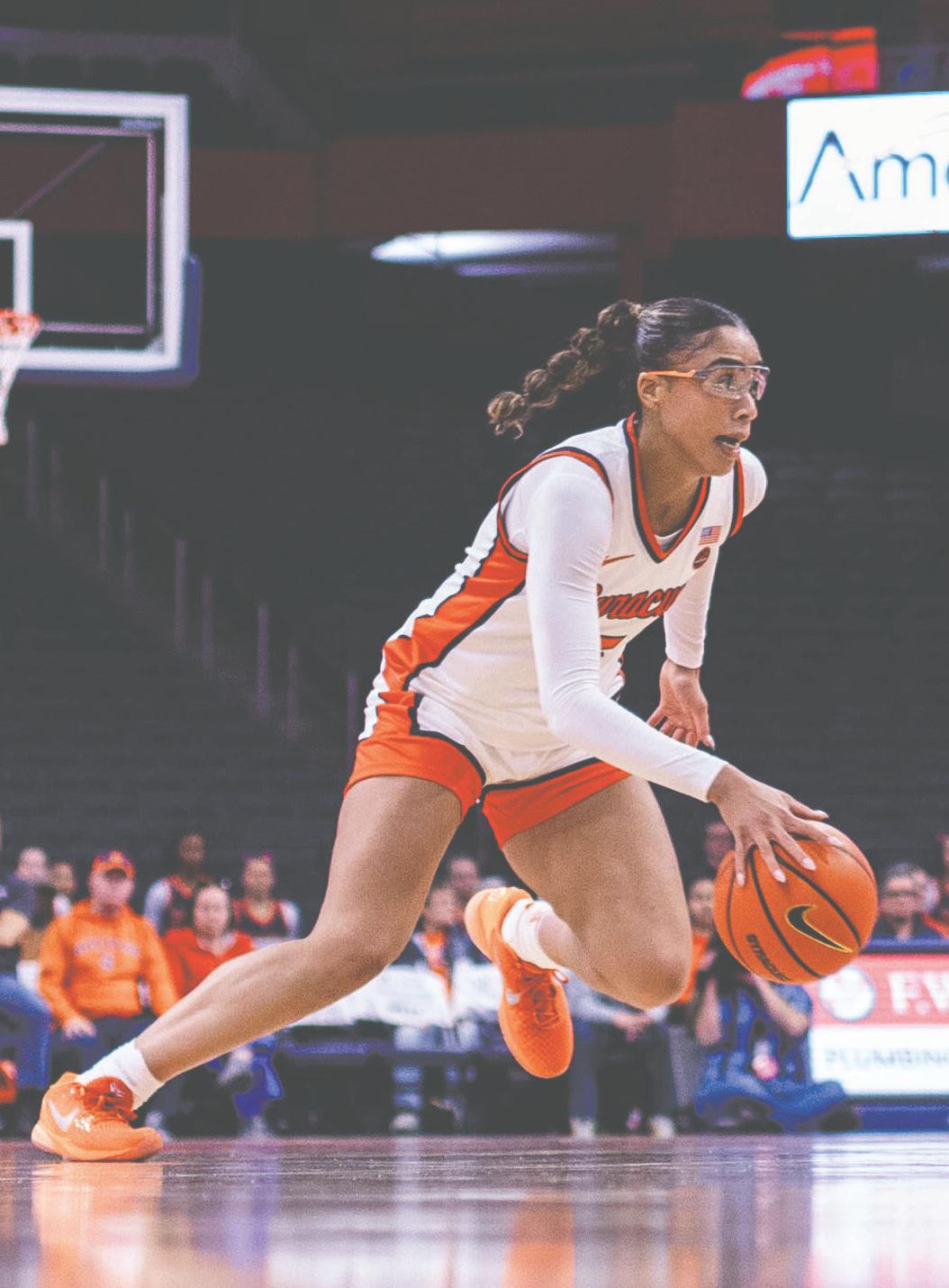
Burrows said. “From the moment (Phelia and fellow captain Dominique Darius) stepped on the court, it was pretty obvious they were gonna be good leaders.”
Phelia will need time to rediscover her game after spending a year on the bench. The goggles she now has to wear on the court are a constant reminder of her misfortune over the past year and a half. But they also symbolize a new era for the guard who once lit up the Big Ten.
Phelia said this year is about proving to herself she can overcome the obstacle hurled her way last fall. And so far, she’s been successful in doing so. A few weeks ago, Phelia called her mom to give an update on her preseason progress. Her words were exactly what she — and Syracuse — wants to hear: “I'm feeling like my old self again.”


Naithan George established himself as the ACC’s top passer. He’ll now conduct Syracuse’s symphony.
B
y
A iden Stepansky SENIOR STAFF WRITER
Nmate and instantly feeling anxious.
To calm his nerves, he passed.
The initial fear evolved into a love for seeing teammates succeed. It eventually developed his mastery in dishing the rock.
“Facilitating has been in my game since I touched a basketball,” George said.
After leading the Atlantic Coast Conference with 6.5 assists per game last season, George is the conductor of the orchestra for Syracuse in head coach Adrian Autry’s makeor-break third year. The point guard will pull the strings in SU’s offense, which features an entirely revamped squad with star duo J.J. Starling and Donnie Freeman at the forefront.
Better yet, George is the maestro of the symphony, having already established himself among the country’s elite passers in his sophomore campaign at Georgia Tech. His next act is helping the Orange break a fouryear NCAA Tournament drought.
“I'm a floor general because of the way I control the game,” George said. “Coaches said to me throughout my upbringing to manipulate the game, make the game yours.”
A floor general. George defines the term as someone who could be picked up full court by the opponent’s top defender and still keep their composure. It’s what he saw in point guards like Chris Paul and fellow Canadian Steve Nash, whom George bases his game on.
He adds his personal flavor by creating looks for everyone on the floor. His uncle Mike George, an NBA agent, said he’s always had the innate ability — no pun intended — for a pass-first playstyle. George celebrates a pass just as much as a bucket. It’s part of what made him an attractive piece for the Orange’s offseason plans.
Autry described Syracuse as “all in” on George once he unexpectedly hit the transfer portal. SU general manager Alex Kline categorized its approach as a “full-court press.” The Orange’s entire coaching staff, plus Starling and Freeman, called, FaceTimed and talked over Zoom with George. Conversations focused on the program’s existing pieces and potential new additions. Autry and Co. were well aware that Syracuse ranked 228th in the country with a 49.9% assist rate, per KenPom.
George could be at the center of a fresh operation.
He enjoyed the Orange’s daily consistency in speaking with him and his parents. Mike said George sported offers from schools like Oklahoma, Louisville and Stanford, among others, before he whittled down his options to North Carolina and Syracuse. He revealed both sides were “competitive” financially. Kline said there was never a moment Syracuse had to back out due to the price being too high. In the end, SU’s pitch sealed the deal.
“They explained to him, ‘You can help make this program get back to where it's been,’” Mike said. “And being where he's from, seeing what Tyler Ennis did years ago, he knew the history of the program. And he knew, in his heart, this place can be pretty special.”
Still, George’s comfort with Syracuse’s staff wasn’t built overnight. Mike knew Autry from when he represented Ennis, a fellow Canadian. Autry was Ennis’ main recruiter. Then came the location factor.
The point guard estimates that his eight siblings have seen only a handful of his college games. His father, Anthony George, built a routine of packing a minivan and driving 18 hours from Toronto to Atlanta. Anthony said they’d rent Airbnbs so they could have large dinners with homemade meals. The plan was necessary but unsustainable.
Early in his high school career back in Ontario, George went out for Bishop Reding’s Junior basketball team. Out of 100 students trying out, head coach Michael Campovari said it took just 12. George cracked the roster, but came off the bench in Canada’s
on, George regularly found his way into the starting lineup.
“He had this quick step to him, which allowed him to see the court with the type of vision he had,” Camp ovari said. “It was always there.”
Looking to upgrade his game, George moved across North America to Arizona with Mike. Though he sacrificed his immediate family, they all knew it was best for his basketball aspirations.
George wanted a more competitive environment. His uncle provided that by running Arizona Unity, an elite youth pro gram on the Nike EYBL circuit. Arizona Unity’s assistant program director, Corey Boswell, said when George entered the orga nization, he was more of a scorer. Entering the summer before his senior year, Boswell saw his passing ability grow.
That same summer, he was thrown straight into the fire at Peach Jam — the premier youth basketball tournament. He matched up against top players in the country, like Jeremiah Fears and Tre Johnson — the No. 6 and No. 7 picks in the 2025 NBA Draft, respectively. Though in Boswell’s eyes, his breakout affair was a matchup versus the future No. 2 overall pick, Dylan Harper.


